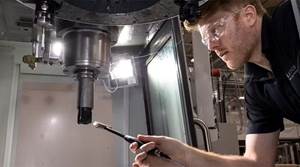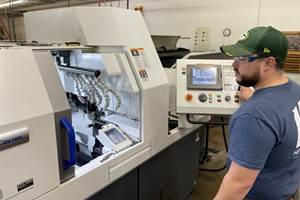Shop Boosts Manufacturing Efficiency...Profits With A...Cost Estimating System
To win jobs from customers that include NASA, aerospace companies, and a variety of petrochemical, oilfield and gas industries, a precision machine shop must respond to an average of 150 customer Requests for Quotes (RFQs) per week.
Share





At Carroll Machine Works (Pasadena, Texas), the ability to produce cost estimates quickly and accurately is a matter of survival. To win jobs from customers that include NASA, aerospace companies, and a variety of petrochemical, oilfield and gas industries, a precision machine shop must respond to an average of 150 customer Requests for Quotes (RFQs) per week.
"We pretty much live and die by our quotes down here, competing for every job," says Carroll Machine Works' (CMW) owner and chief estimator, Wayne Carroll. "Some parts cost $10,000 or more. We had better be estimating accurately, or we lose, big time."
Realizing that manual cost estimating methods couldn't match the incoming stream of RFQs, many with deadlines of 2 and 3 days, Mr. Carroll turned to a customized spreadsheet. The program helped the company to profit on 60 percent of its orders while breaking even or losing money on 40 percent. Although profitable, the system didn't satisfy Mr. Carroll.
After reviewing computer-aided cost estimating options, he purchased the Costimator System by MTI Systems, Inc. The system includes a comprehensive database of proven manufacturing data and knowledge gleaned from a variety of sources.
Mr. Carroll said that Costimator virtually eliminated "losers," jobs that cost more than estimated. The system's speed—50 percent to 80 percent faster than detailed manual estimating—also boosted estimating department output. The system paid for itself in months, says Mr. Carrol who has tailored the system's standards and machine times.
Mr. Carroll emphasized that he now bids jobs with total confidence. "When customers come back and tell me they can get a better deal on a part from someone else, it's a lot easier to resist the temptation to re-bid the job lower," he explains. He adds that machine times generated within Costimator routings are electronically transferred to the shop's scheduling software, improving the management system's accuracy and further increasing company efficiency.
Costimator enables Mr. Carroll—who is chief cost estimator—to spend more time on the shop floor, resolving production issues. He plans to train others on this system and spend more time on manufacturing management. Using this system, employees with basic machining and estimating knowledge can quote accurately, he says.
Mr. Carroll describes quoting a 10 ¼-inch by 10 ¼-inch by 3 ½-inch titanium part for a NASA contract to illustrate the high-stakes estimating process. Cutter paths totaled more than 1,500 inches. "The part had seven irregular pockets, multiple boltholes, an irregular fin configuration and other features that were very tough to machine," he says. "Just one operation had 20 separate features—16 of these were pocket milling. It would have taken me a day and a half to quote if I were estimating manually—and that still would feel like a stab in the dark."
Using Costimator, he quoted the part in an afternoon, well in advance of a 48-hour deadline. Scanning the part drawing into the program, he created a raster pcx file. He then built his estimate, designating a Tree 1260 CNC machining center, choosing each operation and designating tool material and size for the various elements of each operation. Speeds and feeds for Mr. Carroll's tooling choices, calibrated to machine titanium, appeared in the on-screen estimate. As he measured dimensions and tool paths of the machining operations (by tracing his cursor over the on-screen drawing), Costimator calculated machine time and cost. The program automatically allowed for labor rates, PF&D and tool wear. The program also listed the times for inspection operations, as well as fixturing costs.
When all data had been entered, Costimator produced an itemized estimate, process plan and routing. The total manufacturing cost per part was more than $11,000.
While Mr. Carroll played ‘what if,' substituting certain tooling and manufacturing operations, Costimator automatically adjusted the quote's time and cost. He determined that by drilling pockets with an indexable, insertable drill prior to end mill operations (as opposed to removing all material with an end mill), manufacturing would cost about $1,200 less per part.
"When a customer sends us a part drawing, we can make an estimate with Costimator, play ‘what if' and make appropriate recommendations on material and design," Mr. Carroll says. "We can show how engineering changes will affect cost. We are supportive as possible, acting almost like consultants. Customers come to rely on us for advice."
Costimator formulates reports with detailed overviews of different manufacturing options. Currently working out of his own office, Mr. Carroll plans to take Costimator on-site in a laptop and produce process plans, routings and quotes for customers in their offices.
"A customer calls to talk about a part that would take him an hour to process plan and cost out," says Mr. Carroll. "I can take information over the phone and produce a new estimate for him in just 10 minutes. That kind of speed, combined with the reliability of a computerized quote and personalized service to individual customers, makes Costimator an important member of our sales team."
Related Content
How to Mitigate Chatter to Boost Machining Rates
There are usually better solutions to chatter than just reducing the feed rate. Through vibration analysis, the chatter problem can be solved, enabling much higher metal removal rates, better quality and longer tool life.
Read MoreHow this Job Shop Grew Capacity Without Expanding Footprint
This shop relies on digital solutions to grow their manufacturing business. With this approach, W.A. Pfeiffer has achieved seamless end-to-end connectivity, shorter lead times and increased throughput.
Read MoreERP Provides Smooth Pathway to Data Security
With the CMMC data security standards looming, machine shops serving the defense industry can turn to ERP to keep business moving.
Read More2 Secondary Coordinate Systems You Should Know
Coordinate systems tell a CNC machine where to position the cutting tool during the program’s execution for any purpose that requires the cutting tool to move.
Read MoreRead Next
Machine Shop MBA
Making Chips and 91ÊÓƵÍøÕ¾ÎÛ are teaming up for a new podcast series called Machine Shop MBA—designed to help manufacturers measure their success against the industry’s best. Through the lens of the Top Shops benchmarking program, the series explores the KPIs that set high-performing shops apart, from machine utilization and first-pass yield to employee engagement and revenue per employee.
Read MoreLast Chance! 2025 Top Shops Benchmarking Survey Still Open Through April 30
Don’t miss out! 91ÊÓƵÍøÕ¾ÎÛ's Top Shops Benchmarking Survey is still open — but not for long. This is your last chance to a receive free, customized benchmarking report that includes actionable feedback across several shopfloor and business metrics.
Read MoreAMRs Are Moving Into Manufacturing: 4 Considerations for Implementation
AMRs can provide a flexible, easy-to-use automation platform so long as manufacturers choose a suitable task and prepare their facilities.
Read More






















